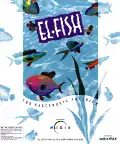El-Fish
El-Fish is a fish and fish-tank simulator and software toy developed by Russian game developer AnimaTek, with Maxis providing development advice. The game was published by Mindscape (v1.1) and later by Maxis (v1.1 + v1.2) in 1993 on 5 diskettes.
| El-Fish | |
|---|---|
 | |
| Developer(s) | AnimaTek |
| Publisher(s) | Maxis |
| Designer(s) | Alexey Pajitnov |
| Platform(s) | MS-DOS, Macintosh, FM Towns |
| Release | March 1993[1] |
| Genre(s) | Life simulation game |
| Mode(s) | Single player |
Each fish in El-Fish has a unique Roe, similar to the genome. This allows the user to catch fish and use selective breeding and mutation to create fish to their own tastes for placing them in virtual aquariums. Around 800 possible genetic attributes (fin shape, body color, size, etc.) are available, which can be selectively shaped into virtually infinite numbers of unique fish. Once fish are created, El-Fish will algorithmically generate up to 256 animation frames so that the fish will appear to swim smoothly around the tank.
The tank simulator is very customizable for this game's era. The player can select from a large number of backdrops and tank ornaments for the fish to swim between. The user can also import their own images to use as tank ornaments. El-Fish includes a fractal based plant generator for creating unique aquarium plants. There are several "moving objects" that can be added to the tanks which the fish will react to, such as a cat paw, fibcrab, and a small plastic scuba diver. The user can also procedurally generate background music for their tank using an in-game composer, or choose a separate MIDI music file to be played for each virtual aquarium, and feed the fish.
The tank simulator can run as a memory-resident program in MS-DOS, making it a screensaver. Multiple tanks can be displayed via El-Fish's slideshow feature.
Development
El-Fish was created by Vladimir Pokhilko, Ph.D. and Alexey Pajitnov (the creator of Tetris), who had backgrounds in mathematics, computer science, and psychology. They were attempting to create software for INTEC (a company that they started) that would be made for "people's souls". They developed this idea, calling it "Human Software", with three rules:
- The software needs to be "aesthetically beautiful"
- The software needs to be constructive
- The software needs to bring feeling to people that they would not otherwise enjoy
El-Fish was developed by many bright minds, most with Ph.D.s, and some had worked on high-profile projects such as the Russian space program.
Although El-Fish's demanding (for its time) system requirements prevented it from selling many units, it was an early version of what would become a very widespread genre.
Performance
| Computer | Catch/Breed/Evolve | Animate |
|---|---|---|
| 386SX16 | 5–7 minutes | 6–7 hours |
| 386DX25 | 3.5–4 minutes | 3.5-4hours |
| 386DX25† | 25–35 seconds | 25–35 minutes |
| 486DX33 | 7–10 seconds | 7–10 minutes |
| 486DX2-66 | 5 seconds | 4–6 minutes |
† Has a math co-processor (sometimes called the "387" chip)
The animating time of a fish depends heavily on its size, where a very small fish can be animated on a 386DX40 with 4MB of RAM in 2–4 hours, a very large fish can take easily up to 24+ hours.
The performance of the game itself in the play mode varies depending how fast/slow the CPU is. The game in the Maxis version measures the speed of the CPU, so on a slow 386 it will only display 1-3 fish at once, but on a 486 it will show 10+ fish. This speed measurement will not work on modern PCs where the CPU speed exceeds the program's maximum and miscalculates the actual speed. For example, the CPU is 3600 MHz, but the program thinks the CPU is too slow and only will display 1-3 fish. This can be solved with several speed limitation software. It does not have to be slowed down to a 486's speed, but it has to fit the programs measurement calculation for displaying the maximum amount of fishes. This varies on the CPU speed. The first Mindscape version of the game does not have this bug.
Reception
| Publication | Score |
|---|---|
| Satellite Times | 92%[2] |
Computer Gaming World stated that "While it's true that the El-Fish graphics are darn close to state-of-the-art, it's questionable as to whether there's enough substance to warrant its purchase". The reviewer, an aquarium owner, criticized the "software toy" on its "inability to sustain the player's interest. Once the aquarium has been created and viewed, there just isn't much else happening", with no simulation of an ecosystem needing ongoing maintenance as he had hoped.[3]
In 1996, Computer Gaming World declared El-Fish the 13th-worst computer game ever released.[4]
References
- "Bulletin - El-Fish". PC Zone. No. 1. Dennis Publishing. April 1993. p. 12.
- Mindscape International Catalogue (PDF). Mindscape. 1993. p. 6.
- Goble, Gordon (July 1993). "A Review of El-Fish from Maxis". Computer Gaming World. p. 118. Retrieved 12 July 2014.
- Staff (November 1996). "150 Best (and 50 Worst) Games of All Time". Computer Gaming World. No. 148. pp. 63–65, 68, 72, 74, 76, 78, 80, 84, 88, 90, 94, 98.
- Michael Bremer (1993). El-Fish: The Electronic Aquarium: User's Manual. Orinda: Maxis.